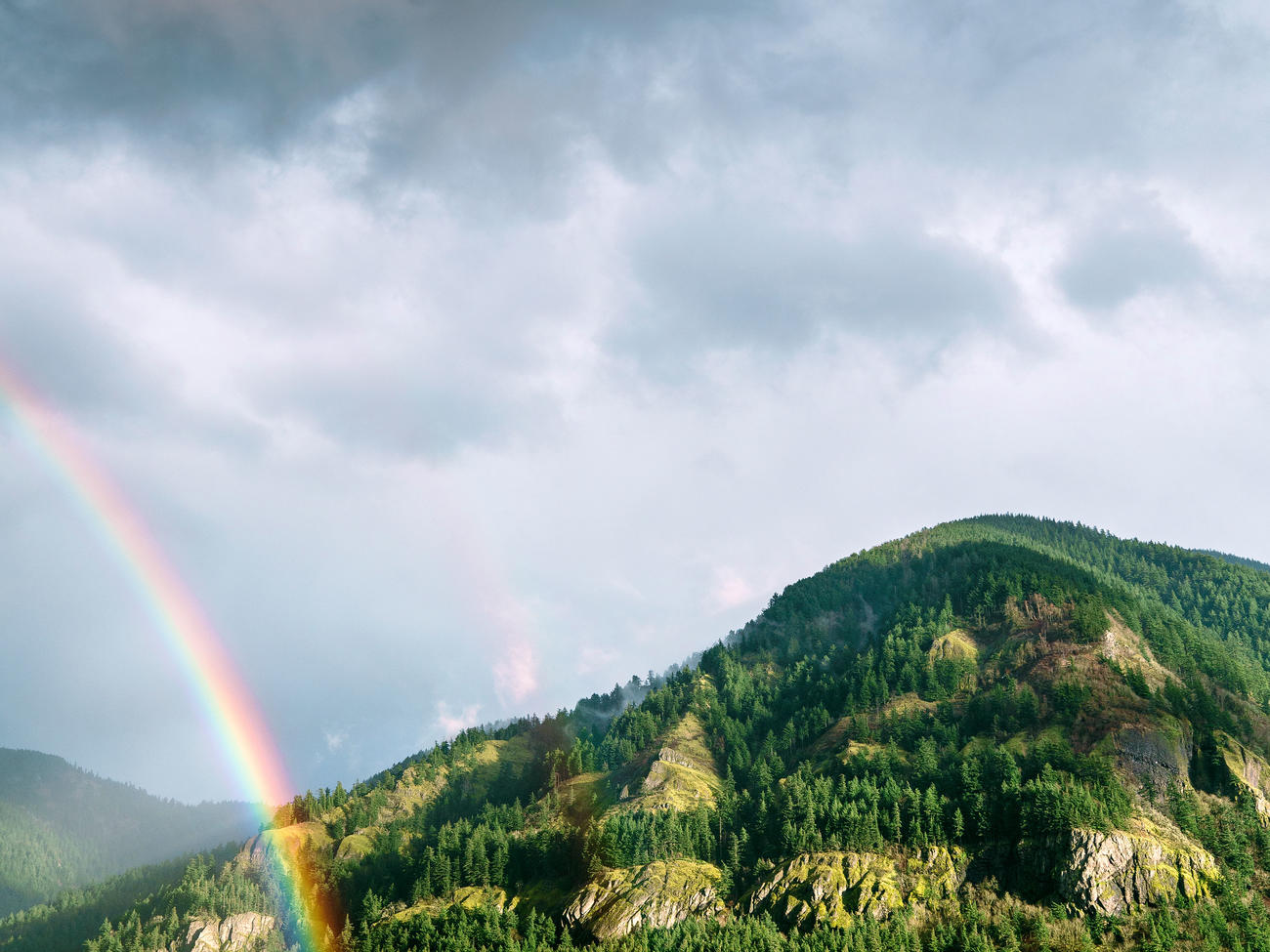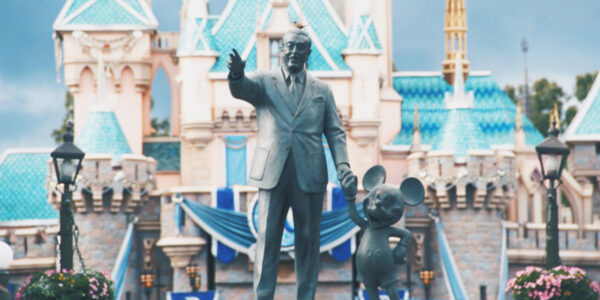
Fresh Eyes on the West
Tracing the path of Lewis and Clark helps us rediscover the meaning of home

The Missouri River. Green water mirrors cottonwoods and willows. Cloud puffs drift across a silent blue sky.
Then: “Bear! Bear!”
As we watch from the opposite bank, hunter George Drouillard, rifle at the ready, plunges into the willows, pursuing a dimly seen brown blur.
Back on our side of the river, a 12-year-old audience member pipes up: “Hey, that’s just a guy in a bear suit.”
Well, yeah, kid, strictly speaking it is just a guy in a bear suit, not a real specimen of Ursus arctos horribilis, the American grizzly. And strictly speaking this is not the Corps of Discovery’s encampment of June 27, 1805, but a modern reenactment performed by the Great Falls, Montana, Lewis & Clark Honor Guard as part of the city’s Lewis & Clark Festival, held each June.
They take their roles seriously, the members of the Honor Guard. Tents, canoes, and rifles are reasonable facsimiles of what Lewis and Clark and their party would have used in 1805. Once the excitement of the bear hunt has died down, Lee Ebeling, a Great Falls engineer who is the Honor Guard’s navigation expert, sits beside his tent and demonstrates his Hadley’s sextant, a near-perfect replica of the one Meriwether Lewis brought on the expedition. “I got this off eBay,” Ebeling explains.
Two centuries ago, Thomas Jefferson sent Meriwether Lewis and William Clark and 30-odd other men ― eventually joined by one 15-year-old Shoshone woman, her trader husband, and their infant child ― across the unknown American West to find easy passage to the Pacific. Two centuries is a long time. But even now their story remains uniquely compelling, unduplicated for heroism and adventure.Best of all, Lewis and Clark’s journey is one that the modern traveler can share. The explorers’ complete route extends more than 8,000 miles, from Camp Wood, Illinois, to the Oregon coast. But the best of the trail ― the most beautiful, the least altered ― lies here in the West. To follow the explorers along the Missouri River, across the Rocky Mountains, and down the Columbia River to the Pacific will show you an American West whose capacity to inspire pleasure and awe remains undiminished.
THE RIVERVerne Huser steers his canoe past a cottonwood snag with the ease of a man who has paddled Western rivers for five decades.
“Clark was a much more experienced river man than Lewis was,” Huser explains between strokes. “He’d traveled up and down the Mississippi and the Ohio.”
We are paddling downstream on the Missouri River, on a trip run by River Odysseys West, for which Huser ― pioneering Western river guide and author ― serves as a Lewis and Clark historian and naturalist.
If you want one experience that will make you feel what traveling with Lewis and Clark might have been like, canoeing Montana’s Upper Missouri National Wild and Scenic River is probably it. Lewis and Clark’s journey was substantially a river journey. And while elsewhere the Missouri has been dammed and reservoired into submission, here it flows beautifully beneath sandstone bluffs, not so different from the river that the Corps traveled in two pirogues and six dugout canoes. Remember, Huser notes, the Corps were traveling upstream. With the right wind, they could raise sails. Otherwise they would paddle. If the current grew too strong, they would pole the boats upriver or, worse, tow them by hand, struggling against muddy river bottoms and rattlesnake-infested banks. “Imagine towing these boats through swift, cold water ― they were here in May, the river was running fast with snowmelt,” Huser says. “It was tough. They worked their bones off.” We don’t. The dozen of us on this trip are in that idyllic position of being vicariously thrilled by hardships we don’t have to endure. We paddle easily downstream along a midsummer Missouri made for jumping into when the day gets hot, with plenty of time allowed for water fights and hikes and dinners around the campfire.Still. What does come through is the newness of the land, its immensity. No European American had been here before Lewis and Clark arrived. We hike to Hole in the Wall ― a chiseled gap in the sandstone cliffs ― and view the Missouri curling lazy as a lizard below us. We note what Lewis noted: “The hills and river Clifts which we passed today exhibit a most romantic apperance. … As we passed on it seemed as if those seens of visionary inchantment would never have and end.”
Romantic. Enchantment. As usual, the poetic yet precise Lewis gets things right ― in this case, the effect this landscape has on you.At the start of our voyage, we had paused to see where Marias River flows into the Missouri; Lewis named it for a cousin he may have been sweet on. Now, near trip’s end, we pass the Judith River, which Clark named for the woman he would marry in 1808. The link between geography and passion seems appropriate. After five days on the river, we understand how the West can hit you with the force of new love ― the kind of love that makes you run away and change your life and become someone entirely new.
THE MOUNTAINS The journey changes. On July 25, 1805, the Corps determine they have reached the Missouri’s headwaters, near what is now Three Forks, Montana. They follow one fork, the newly named Jefferson, southwest. But without the Missouri to guide them, they lose certainty. A confusing maze of mountains rises to the west. There is another change. As the Corps cross the Montana plains, they encounter none of the native peoples who live there. The Assiniboins and Blackfeet surely know of the strangers’ presence. But they choose not to reveal themselves.Now the stories of the mountains and the peoples who live in them intertwine. The Corps’ 15-year-old interpreter, Sacagawea ― the most widely used spelling, although some prefer “Sacajawea” instead ― begins to recognize landmarks. Here is home: the country from which she was kidnapped five years earlier. On August 17, Lewis, who had been traveling ahead of the main party, escorts a group of Lemhi Shoshone back to the site the Corps have dubbed Camp Fortunate.
The account of this meeting still brings a lump to the throat. Sacagawea, Clark recorded, “danced for the joyful Sight, and She made signs to me that they were her nation.” She had found her people. One of them, Chief Cameahwait, was her brother. (“A man of Influence, Sence, & easey & reserved manners,” praised Clark, as if the chief were a marriageable hero out of Jane Austen.) Cameahwait sold the expedition needed horses, lent them a guide, whom the captains called Old Toby, and offered invaluable advice about proceeding west.
So, let Sacagawea and her people be your guides through their part of the world. Start near Three Forks in Missouri Headwaters State Park, still remarkably unspoiled, then take Interstate 90 and State 41 south to the college town of Dillon, Montana, where you can admire the old- fashioned diorama of the Corps at the town’s visitor center. Drive south on Interstate 15 to the site of Camp Fortunate, now submerged beneath Clark Canyon Reservoir.Part of the fun of following Lewis and Clark is the chance to drive backroads. Here’s a superlative one: Head east on State 324, south on Forest Road 3909, then drive up Lemhi Pass Road through deceptively gentle hills to 7,373-foot-high Lemhi Pass. (The dirt-and-gravel road is generally open June to October ― check before you set out ― and is suitable for passenger cars.) At the crest of the Continental Divide, you’ll see one of the West’s most breathtaking views: to the west, ridge upon ridge of mountains; to the east, the full sweep of prairie Montana. Then you follow steep, curvy Agency Creek Road down into Idaho’s Lemhi River Valley.
Last year, Salmon, Idaho, opened the Sacajawea Interpretive, Cultural, and Education Center. Exhibits and an interpretive trail tell the story of the heroine and her tribe. “Sacagawea is mythical, almost,” says center director Gary Van Huffel. “But the Lemhi Shoshone feel her strength comes from her Shoshone upbringing.” From Salmon, take U.S. 93 north over Lost Trail Pass, then drop down into Montana’s Bitterroot Valley. At Travelers’ Rest State Park, archaeologists have discovered interesting if ignoble traces of the expedition: mercury deposits in the camp latrine, remnants of the Corps cure-all, Dr. Benjamin Rush’s Thunderclappers. Now west again, up U.S. 12 to Lolo Pass. Here is another case where the gap between the Corps’ experience and ours widens into a chasm. Struggling over the Bitterroots in September of 1805, Lewis and Clark endured fierce hunger and brutal weather: “I have been wet and as cold in every part as I ever was in my life,” wrote Clark.Today the drive is pure beauty. The highway climbs mountainsides veiled by mist, solemn with cedars, with silver streams ― Lolo Creek, Lochsa River ― shining below. An adolescent black bear tumbles across the road ahead, clowning, oblivious, before vanishing into forest.
In a few hours, you reach Weippe Prairie. Perhaps it is a mistake to oversell this site, one beloved by Lewis and Clark enthusiasts. There is not that much to do here. The town of Weippe has opened an interpretive center that features murals of the expedition; out on the prairie proper, you can see a large sign that explains what took place here.And yet Weippe Prairie is one of the most evocatively beautiful places anywhere along the trail: a high rolling plain, seemingly suspended between earth and cloud. Here, on September 20, a nearly starving Clark staggered out of the mountains to encounter members of the Nez Perce tribe. According to oral tradition, one was an elderly woman named Watkuweis, who advised her suspicious fellow tribe members not to kill the newcomers but to treat them well.
In this way, Lewis and Clark’s travels through the harsh mountains are bookended on the west and east by striking examples of Native American generosity. In Lapwai, Idaho, tribe member Ethel Greene is in charge of the Nez Perce’s participation in the Lewis and Clark bicentennial. It has not been easy, Greene says, to share a story that holds such a strongly mixed message. After all, many of the strangers who came after Lewis and Clark were noticeably less benign. Lewis and Clark’s bicentennial, Greene says, “is not a celebration to us. It is an observance. Remember, if we had not allowed them to come in, if we had killed them, well, that would have changed everything.” TO THE SEANever underestimate the power of a good ending. If you consider Lewis and Clark’s journey our American epic, an Odyssey decked out in leather breeches, then their final sprint to the Pacific provides a suitably grand finale.
“Took our leave … and proceeded on down the great Columbia river,” Clark wrote on October 18, 1805. Great it was, and is. Like the Missouri, the Columbia has been altered from the river that the Corps traveled. The vast waterfalls, like Celilo, have been drowned by dams, and the wild waters (“agitated gut Swelling, boiling & whorling in every direction,” Clark complained) calmed into pools amenable to windsurfing. But the sight of the still-powerful river flowing beneath stately basalt cliffs is a spectacle of almost classical grandeur.
At Pillar Rock, near what is now Altoona, Washington, they glimpsed what they had come for. “Great joy in camp we are in View of the Ocian, this great Pacific Octean which we been So long anxious to see,” wrote Clark. Historians now dispute whether Clark could have seen the ocean from this site. But give the Corps their moment of joy. They would need it.
For as they neared their goal, the elements fought to stop them. The weather was sodden; they could not find level ground to camp. Finally, they reached the Washington coast, lingered there a few days, then opted to make their winter camp on the other side of the river, in Oregon.
These shores are now among the most visitor-friendly places to learn about Lewis and Clark. At Cape Disappointment State Park, in Ilwaco, Washington, the newly expanded Lewis and Clark Interpretive Center lets you retrace the Corps’ route downriver, and it introduces you to the sophisticated Chinook tribe the party encountered.
“Remember,” says interpretive specialist Ryan Karlson, “the Chinook had been dealing with fur traders for some years. Lewis and Clark didn’t expect to find natives wearing top hats, speaking a little English. But they did.”
Across the river, Fort Clatsop National Memorial re-creates the fort that the Corps built for their winter stay in 1805-06. Here Dick Basch, a Clatsop who is working with the bicentennial planners, has a wry appreciation for the Corps’ dealings with his people.
“They were clumsy traders,” Basch says. “These guys showed up with a few beads, a few fishhooks, their clothes rotting off them. We felt sorry for them. Look at their fort ― how the roof slopes in to the courtyard so all the rain pours down on them. I am sure the Clatsop said, ‘What the hell are they thinking?’ “
The Corps stayed at Fort Clatsop for 106 days, of which it rained every day but 12. Yet the inclement weather was in some ways a blessing. It forced Lewis and Clark to stay inside, to work on their journals, to tally the miles they had traveled, the number of new species discovered ― 178 plants and 122 animals, by present count ― and to gauge the magnitude of their achievement.
After you inspect Fort Clatsop, you’ll want to go down and gaze at the Corps’ final goal. “The Great Western Ocian,” Clark called it, adding, “I cant Say Pasific as Since I have Seen it, it has been the reverse.” But then the sea’s mighty pounding ― “repeeted roling thunder,” said Clark ― still provides a suitable drumroll for what was achieved. The waves shake this Oregon beach as if recognizing, 200 years later, that here a new American nation, spanning an entire continent, was born.